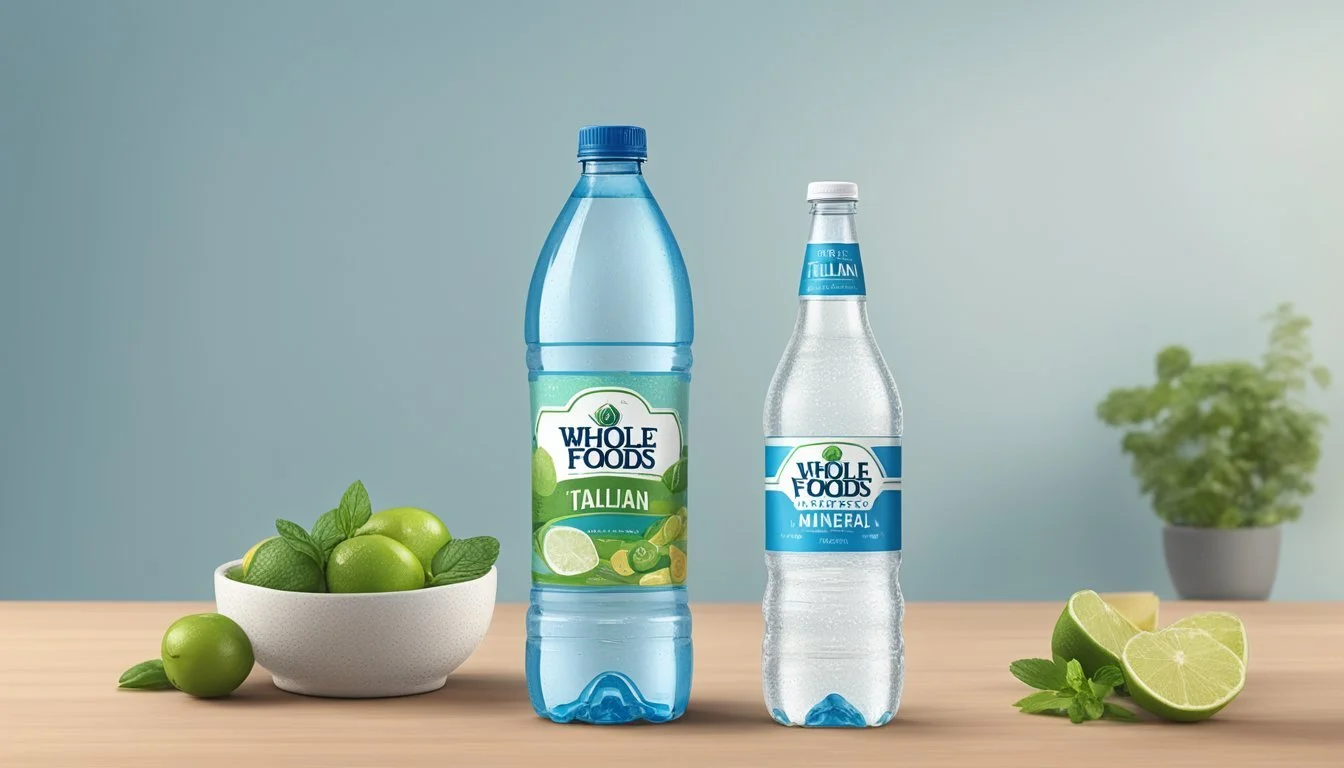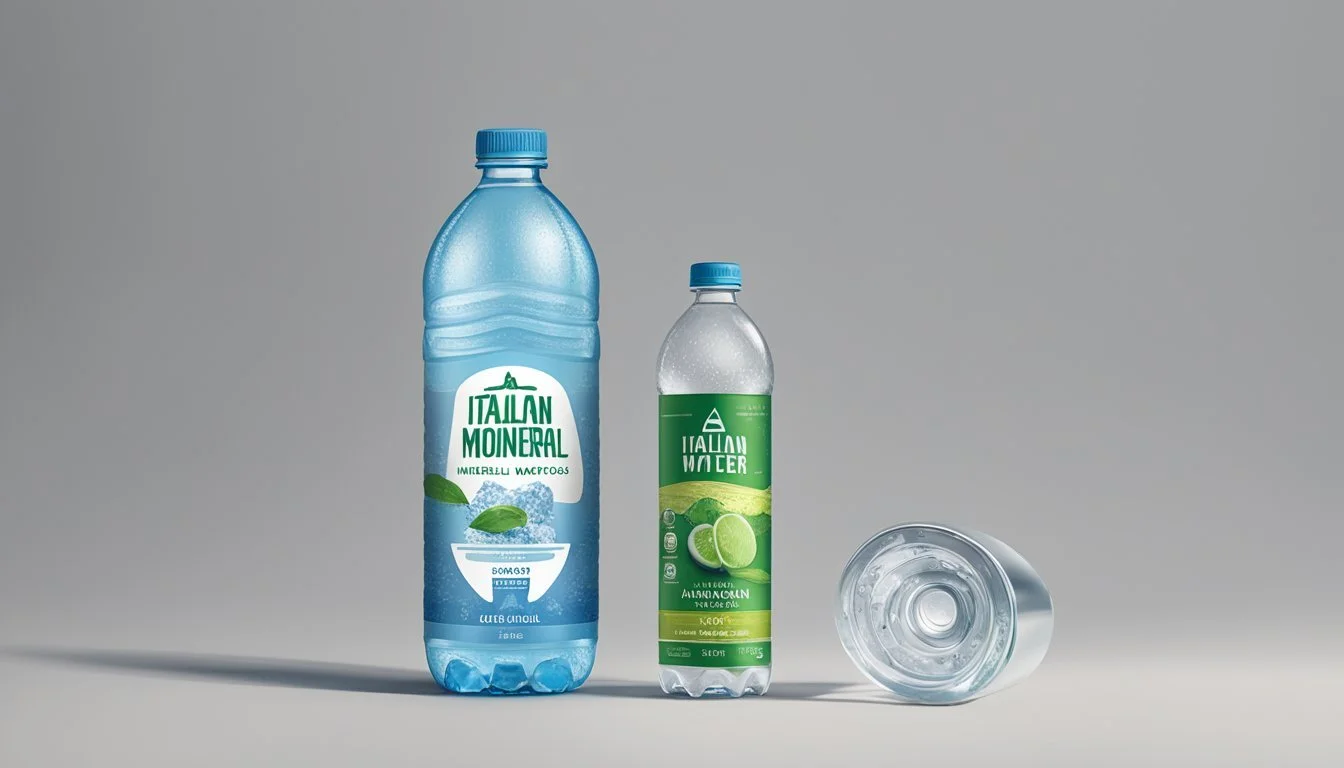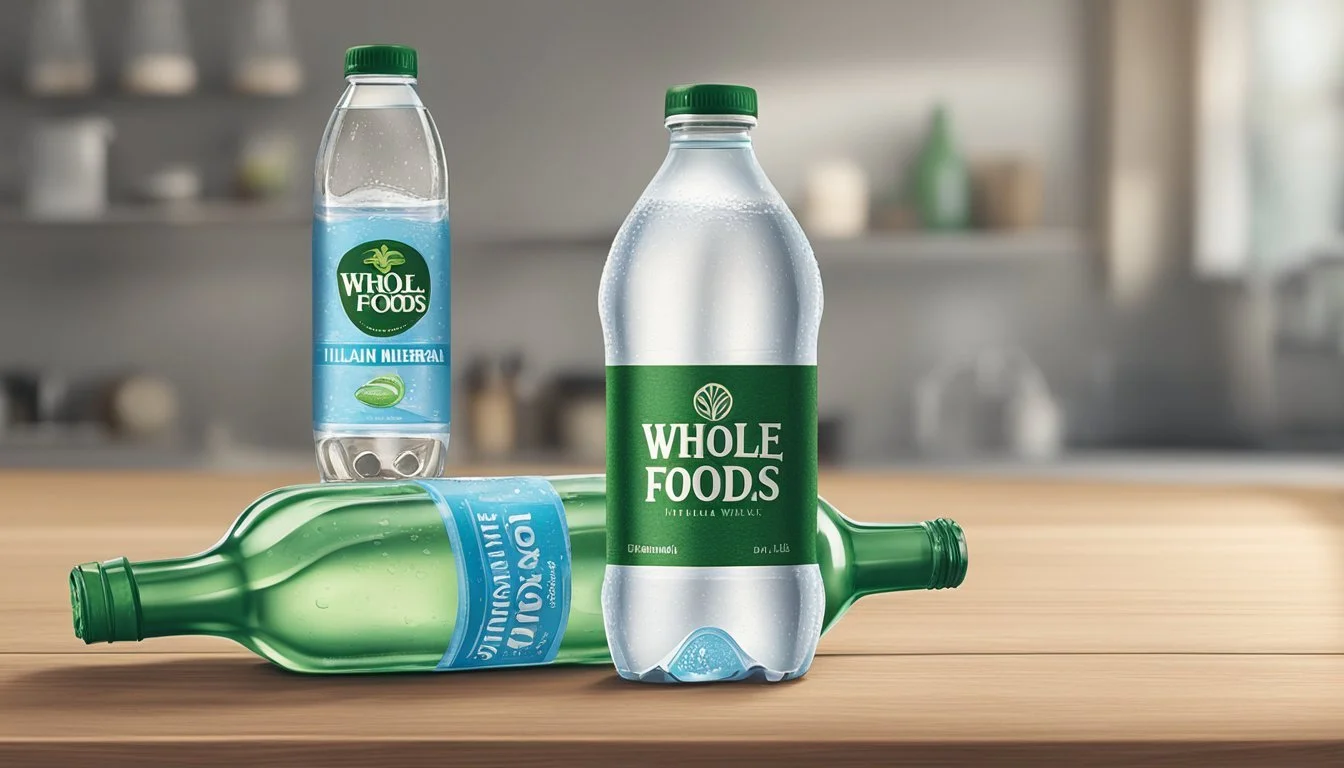Whole Foods Italian Still Mineral Water vs. Action
A Comparative Analysis
Choosing the right bottled water can be an intriguing journey, especially when comparing two distinct products like Whole Foods Italian Still Mineral Water and Action. Whole Foods' option is sourced from renowned regions in Italy, known for their commitment to purity and health benefits. In contrast, Action offers a unique blend with a neutral taste profile that complements various culinary settings.
Whole Foods Italian Still Mineral Water is celebrated for its sustainable practices and quality standards. The TDS content of its sparkling variant falls between 150-200, indicating a moderate level of minerals that contribute to its crisp taste. On the other hand, Action stands out in its category by providing a more subtle, clean flavor, making it a versatile choice for pairing with food.
For those considering cost, Italian bottled waters, whether from Whole Foods or other brands, can range significantly in price. Action typically falls within competitive pricing, ensuring that consumers can indulge in quality without breaking the bank. Readers seeking a well-rounded water experience might find Whole Foods' Italian Still satisfies both their palate and their ecological values, while Action excels in simplicity and culinary flexibility.
Overview of Bottled Water
Bottled water has become a staple in modern hydration, offering various choices from mineral-rich to purified options. This section explores the factors behind bottled water's popularity and the differences between mineral and still varieties.
The Rise of Bottled Water Consumption
Over the past few decades, bottled water has surged in popularity. Convenience plays a significant role, as pre-packaged water is readily available for on-the-go hydration.
Health consciousness has also contributed. Many consumers prefer bottled water over sugary beverages, viewing it as a healthier choice. Brands emphasize purity, often marketing their water as free from contaminants.
The rise of environmental awareness has spurred innovations in packaging. Recyclable and biodegradable bottles are increasingly common, addressing concerns about plastic waste.
Mineral Water vs. Still Water: Understanding the Basics
Mineral water comes from natural springs and contains various minerals like calcium and magnesium. It's often prized for its taste and perceived health benefits.
Still water refers to non-carbonated, purified water. Brands use methods such as reverse osmosis to remove impurities, ensuring a clean taste.
Both types offer different experiences. Mineral water's natural origins can enhance flavor profiles, while still water provides a neutral, crisp refreshment. When choosing, it often comes down to personal preference and specific hydration needs.
Examining Whole Foods Italian Still Mineral Water
Whole Foods Italian Still Mineral Water comes from select springs in Italy, offering a budget-friendly option without compromising on quality. This section explores its origin, mineral content, taste, health benefits, and sustainability.
Origin and Source
Whole Foods Italian Still Mineral Water is sourced from natural springs in Italy. Specifically, it is bottled at the La Galvanina Spa Source in Rimini, ensuring a consistent and reliable supply. The Italian origin provides a unique mineral composition due to the region's geology. This naturally sourced water aims to provide purity and authenticity, adhering to European standards for bottled waters.
Mineral Composition
The mineral content of Whole Foods Italian Still Mineral Water includes essential minerals like calcium and magnesium. These contribute to its distinct taste and potential health benefits. The Total Dissolved Solids (TDS) level ranges between 150 and 200 mg/L. This mineral-rich profile supports hydration while providing essential nutrients. The pH level is slightly acidic, around 5, which can affect taste but is still safe for consumption.
Taste Profile
This water offers a refined taste profile, attributed to its balanced mineral content. The slight acidity contributes to a refreshing mouthfeel, making it a desirable choice for consumers. The taste is subtle yet distinct, lacking any overpowering mineral flavors. It's positioned as a versatile option, suitable for drinking alone or pairing with various foods without altering their tastes.
Health Benefits
The health benefits of Whole Foods Italian Still Mineral Water stem from its mineral composition. Calcium supports bone health, while magnesium aids in muscle function and overall metabolism. Regular consumption can contribute to daily hydration needs and assist in maintaining electrolyte balance. Its relatively low sodium content makes it suitable for a health-conscious audience.
Sustainability and Purity
Whole Foods emphasizes sustainability in its bottled water products. The water is sourced responsibly from naturally replenishing springs. Bottling practices follow eco-friendly standards, and packaging is often made from recyclable materials. Purity is a key focus, with stringent quality control measures ensuring the absence of contaminants. This commitment to sustainability and purity aligns with consumers' growing environmental concerns.
Italian Still Mineral Water Brands
Italian still mineral water brands encompass a variety of options, each offering unique characteristics and appealing to different preferences. Key brands include San Pellegrino and Acqua Panna, as well as other notable names in the market.
San Pellegrino and Acqua Panna
San Pellegrino is renowned globally for its sparkling water but also produces high-quality still mineral water. Originating from the San Pellegrino Terme region in Italy, it boasts a balanced mineral content and a crisp taste. Acqua Panna, another famous Italian brand, is sourced from Tuscany's Apennine Mountains. It is known for its remarkably smooth texture and neutral pH, making it a popular choice for pairing with fine foods.
San Pellegrino's still water maintains the brand's commitment to purity and quality, ensuring consumer trust. Acqua Panna, often considered a premium option, provides a delicate taste that complements both casual and gourmet dining experiences. Both brands are highly regarded for their signature elegance and consistent quality.
Other Notable Brands
Beyond San Pellegrino and Acqua Panna, other significant players in the Italian still mineral water market include Whole Foods' Italian Still Mineral Water and less internationally known brands like Antipodes.
Whole Foods' brand offers a more budget-friendly alternative without compromising on the essential characteristics of Italian mineral water. This product is sourced from selected springs in Italy, ensuring purity and a satisfactory mineral content.
Antipodes, though originally from New Zealand, is often noted in comparisons for its low mineral content and neutral pH, distinguishing it from Italian options. It offers a cleaner, more understated taste, catering to those who prefer less mineralized water.
Together, these brands represent the diversity and excellence of Italian still mineral water, each providing distinct advantages suited to various tastes and occasions.
Health Implications and Benefits
Whole Foods Italian Still Mineral Water and Action offer a variety of health benefits, differing slightly in mineral content. This affects health aspects such as bone strength, muscle function, digestion, hydration, heart health, and cognitive functions.
Bone and Muscle Health
The mineral content of Whole Foods Italian Still Mineral Water contributes significantly to bone and muscle health. Rich in calcium and magnesium, this water supports bone density and strength. Calcium is crucial for maintaining bone structure, while magnesium aids in bone mineralization and plays a vital role in muscle function.
Potassium is another key element, assisting in muscle contractions and reducing cramping. These minerals, combined with low sodium levels, make it an excellent choice for those focusing on skeletal and muscular health.
Digestion and Hydration
Proper hydration is essential for efficient digestion. Whole Foods Italian Still Mineral Water, with its balanced composition, aids in maintaining hydration levels. The presence of magnesium can help regulate the digestive system and alleviate issues such as constipation.
Potassium plays a role in fluid balance, ensuring efficient absorption of nutrients. The water’s mineral-rich profile supports overall digestive health, making it a beneficial addition to daily dietary intake.
Cardiovascular and Cognitive Functions
Cardiovascular health may benefit from the consumption of Whole Foods Italian Still Mineral Water due to its mineral content. Magnesium is known to help maintain a steady heart rhythm and reduce blood pressure. Additionally, potassium supports heart function by regulating fluid balance and reducing the strain on blood vessels.
Cognition is influenced by hydration and nutrient intake, with magnesium playing a role in brain health and cognitive functions. This water provides essential minerals that support the cardiovascular system and brain function, contributing to overall wellness.
In conclusion, the mineral composition of Whole Foods Italian Still Mineral Water plays a crucial role in enhancing bone, muscle, digestive, cardiovascular, and cognitive health.
Chemical Properties and Mineral Content
Whole Foods Italian Still Mineral Water and Action are both renowned for their purity and mineral content. This comparison will highlight key aspects like mineral concentrations, natural filtration processes, and quality assurance measures.
Comparing Mineral Concentrations
Both waters offer a unique mix of essential minerals and trace elements. Whole Foods Italian Still Mineral Water has higher levels of calcium and magnesium, essential for bone health and metabolic functions.
Action water, while also rich in minerals, prioritizes lower sodium content. Trace elements, such as sulfates and bicarbonate, vary between the two. Consumers might prefer one over the other based on these differences.
Mineral Whole Foods Italian Still Mineral Water Action Calcium High Moderate Magnesium High Moderate Sodium Low Very Low Sulfates Moderate Low Bicarbonate Moderate High
Natural Filtration Process
Natural filtration significantly influences the mineral composition. Whole Foods Italian Still Mineral Water is sourced from Italian springs with a lengthy natural filtration process through layers of limestone.
This process enriches the water with minerals and gives it a distinctive taste. On the other hand, Action water undergoes a shorter filtration process but utilizes advanced techniques to maintain purity and taste.
Natural filtration not only enhances mineral properties but also ensures the elimination of impurities.
Regulations and Quality Assurance
Both products adhere to stringent quality standards. Whole Foods Italian Still Mineral Water is regulated by the EPA and complies with European water standards. Regular testing ensures it meets all safety requirements.
Action water follows rigorous quality checks and is certified by various health authorities. Their quality assurance measures include continuous monitoring and testing for contaminants.
Consumers can rest assured that both brands offer safe drinking water that meets high-quality standards. Frequent audits and detailed label information provide transparency about mineral content and source.
Taste and Culinary Use
Whole Foods Italian Still Mineral Water presents a distinct flavor profile suited for different culinary applications. Its taste and use in upscale dining and cooking make it a preferred choice for many chefs and food enthusiasts.
Flavor Profiles of Italian Mineral Waters
Whole Foods Italian Still Mineral Water boasts a clean, pure taste with a neutral pH balance. This high level of purity ensures that it does not interfere with the flavors of food, making it ideal for pairing with a variety of dishes. The absence of any significant mineral taste allows the natural flavors of the food to shine.
In comparison, other Italian mineral waters might have more pronounced mineral notes, which can either complement or overpower certain foods, depending on their composition. For instance, some waters may contain higher levels of calcium or magnesium, adding a slight chalkiness or bitterness.
The key characteristic of Whole Foods Italian Still Mineral Water is its smooth and subtle palate, making it an excellent choice for those who prefer a neutral taste experience.
Use in Upscale Dining and Cooking
In upscale dining, the choice of water can significantly enhance the dining experience. Whole Foods Italian Still Mineral Water is frequently selected for its ability to cleanse the palate without leaving any aftertaste. This quality is particularly beneficial when served alongside delicate dishes such as seafood or light salads, where the purity of flavors is paramount.
Chefs also utilize this water in the preparation of sophisticated dishes. Its low mineral content ensures that it does not alter the taste of finely balanced recipes. For instance, when used for making broths or sauces, Whole Foods Italian Still Mineral Water maintains the intended flavor integrity.
In baking, the use of pure water can influence the texture and rise of the dough, making Whole Foods Italian Still Mineral Water a favored choice among pastry chefs who seek consistency and perfection in their creations. Its versatility in both preparation and serving underscores its value in high-end culinary settings.
Environmental Considerations
Both brands place significant emphasis on minimizing their environmental impact, focusing extensively on eco-friendly practices and the consequences of plastic waste and carbon emissions.
Eco-Friendly Practices in Bottling
Whole Foods Italian Still Mineral Water is sourced from natural springs in Italy, and Whole Foods is known for its commitment to sustainability. They use bottling methods aimed at reducing environmental footprints, including recyclable packaging and energy-efficient machinery.
Action Bottled Water, recognized for its purification process, also emphasizes eco-friendly practices. They employ advanced filtration systems that reduce water waste. Additionally, their manufacturing plants are often located near the water source to minimize transportation emissions.
Impact of Plastic Waste and Carbon Emissions
Plastic waste remains a significant concern in bottled water production. Whole Foods utilizes recyclable bottles and actively encourages recycling programs to mitigate plastic waste. They monitor their plastic usage carefully to reduce their environmental footprint.
Carbon emissions are another critical issue. Whole Foods aims to lower emissions through logistics optimizations, reducing the distance bottles travel. Meanwhile, Action leverages local sourcing and strives for carbon-neutral delivery options.
Both brands recognize the need for environmental stewardship and implement strategies to minimize their impact on the planet.
Consumer Information
Whole Foods Italian Still Mineral Water presents a noteworthy option due to its origin and company values. This section provides key insights into its labeling, nutritional details, availability, and pricing.
Labeling and Nutritional Information
Whole Foods Italian Still Mineral Water is sourced from natural springs in Italy, reflecting an emphasis on purity and mineral content. The label clearly indicates the source and the mineral composition, including calcium, magnesium, bicarbonates, and sulfates. Important health information, such as sodium content, is also listed, which is critical for consumers monitoring their intake.
The label also emphasizes Whole Foods Market’s commitment to sustainability, with details on the recyclable nature of the bottle. Additionally, consumers can find certifications and quality marks that assure the water's adherence to international standards. This transparency instills confidence about the water's health benefits.
Availability and Pricing
Whole Foods Italian Still Mineral Water is primarily available at Whole Foods Market locations. The water is also accessible through their online store, making it convenient for customers who prefer online shopping. Due to the brand's distribution network, it can be found across various regions, ensuring broad access.
Pricing reflects the premium quality and imported nature of the product. Typically, a 1-liter bottle costs around $1.99, but prices can vary based on location and promotional offers. Multi-pack options are also available, often providing cost savings for regular buyers. This pricing strategy positions it as a competitive option among premium bottled water brands.
More About Whole Foods Italian Still Mineral Water
Acqua Pana vs Whole Foods Italian Still Mineral water: Which Bottled Water is Better?
Antipodes vs Whole Foods Italian Still Mineral water: Which Bottled Water is Better?
Aqua Carpatica vs Whole Foods Italian Still Mineral water: Which Bottled Water is Better?
Aquafina vs Whole Foods Italian Still Mineral water: Which Bottled Water is Better?
Arrowhead vs Whole Foods Italian Still Mineral water: Which Bottled Water is Better?
Bai vs Whole Foods Italian Still Mineral water: Which Bottled Water is Better?
Boxed Water vs Whole Foods Italian Still Mineral water: Which Bottled Water is Better?
Castle Rock vs Whole Foods Italian Still Mineral water: Which Bottled Water is Better?
Core Hydration vs Whole Foods Italian Still Mineral water: Which Bottled Water is Better?
Deer Park vs Whole Foods Italian Still Mineral water: Which Bottled Water is Better?
Erewhon vs Whole Foods Italian Still Mineral water: Which Bottled Water is Better?
Essentia vs Whole Foods Italian Still Mineral water: Which Bottled Water is Better?
Eternal vs Whole Foods Italian Still Mineral water: Which Bottled Water is Better?
Ethos vs Whole Foods Italian Still Mineral water: Which Bottled Water is Better?
Evian vs Whole Foods Italian Still Mineral water: Which Bottled Water is Better?
Fiji vs Whole Foods Italian Still Mineral water: Which Bottled Water is Better?
Flow vs Whole Foods Italian Still Mineral water: Which Bottled Water is Better?
Hawaii Volcanic vs Whole Foods Italian Still Mineral water: Which Bottled Water is Better?
Hawaiian Springs vs Whole Foods Italian Still Mineral water: Which Bottled Water is Better?
Ice Mountain vs Whole Foods Italian Still Mineral water: Which Bottled Water is Better?
Icelandic Glacial vs Whole Foods Italian Still Mineral water: Which Bottled Water is Better?
Just Water vs Whole Foods Italian Still Mineral water: Which Bottled Water is Better?
LIFEWTR vs Whole Foods Italian Still Mineral water: Which Bottled Water is Better?
Liquid Death vs Whole Foods Italian Still Mineral water: Which Bottled Water is Better?
Mananalu vs Whole Foods Italian Still Mineral water: Which Bottled Water is Better?
Nestle Pure Life vs Whole Foods Italian Still Mineral water: Which Bottled Water is Better?
Origin vs Whole Foods Italian Still Mineral water: Which Bottled Water is Better?
Ozarka vs Whole Foods Italian Still Mineral water: Which Bottled Water is Better?
Path vs Whole Foods Italian Still Mineral water: Which Bottled Water is Better?
Penta vs Whole Foods Italian Still Mineral water: Which Bottled Water is Better?
Perrier vs Whole Foods Italian Still Mineral water: Which Bottled Water is Better?
Poland Spring vs Whole Foods Italian Still Mineral water: Which Bottled Water is Better?
Purely Sedona vs Whole Foods Italian Still Mineral water: Which Bottled Water is Better?
San Pellegrino vs Whole Foods Italian Still Mineral water: Which Bottled Water is Better?
Smartwater vs Whole Foods Italian Still Mineral water: Which Bottled Water is Better?
Solan de Cabras vs Whole Foods Italian Still Mineral water: Which Bottled Water is Better?
Starkey vs Whole Foods Italian Still Mineral water: Which Bottled Water is Better?
Tahoe vs Whole Foods Italian Still Mineral water: Which Bottled Water is Better?
Topo Chico vs Whole Foods Italian Still Mineral water: Which Bottled Water is Better?
Tru Alka vs Whole Foods Italian Still Mineral water: Which Bottled Water is Better?
Volvic vs Whole Foods Italian Still Mineral water: Which Bottled Water is Better?
Voss vs Whole Foods Italian Still Mineral water: Which Bottled Water is Better?
Waiakea vs Whole Foods Italian Still Mineral water: Which Bottled Water is Better?
Whole Foods Italian Still Mineral water vs 1907water: Which Bottled Water is Better?
Whole Foods Italian Still Mineral water vs 7-Select: Which Bottled Water is Better?
Whole Foods Italian Still Mineral water vs Alkaline88: Which Bottled Water is Better?
Whole Foods Italian Still Mineral water vs Augi: Which Bottled Water is Better?
Whole Foods Italian Still Mineral water vs Big Chill: Which Bottled Water is Better?
Whole Foods Italian Still Mineral water vs Big Win: Which Bottled Water is Better?
Whole Foods Italian Still Mineral water vs Blk: Which Bottled Water is Better?
Whole Foods Italian Still Mineral water vs BodyArmor: Which Bottled Water is Better?
Whole Foods Italian Still Mineral water vs Cascade Mountain: Which Bottled Water is Better?
Whole Foods Italian Still Mineral water vs CBD Living: Which Bottled Water is Better?
Whole Foods Italian Still Mineral water vs Cirro: Which Bottled Water is Better?
Whole Foods Italian Still Mineral water vs Crystal Geyser: Which Bottled Water is Better?
Whole Foods Italian Still Mineral water vs Crystal Lake: Which Bottled Water is Better?
Whole Foods Italian Still Mineral water vs Dasani: Which Bottled Water is Better?
Whole Foods Italian Still Mineral water vs Defy: Which Bottled Water is Better?
Whole Foods Italian Still Mineral water vs Essence pH10: Which Bottled Water is Better?
Whole Foods Italian Still Mineral water vs HFactor: Which Bottled Water is Better?
Whole Foods Italian Still Mineral water vs Kirkland Signature: Which Bottled Water is Better?
Whole Foods Italian Still Mineral water vs Kroger: Which Bottled Water is Better?
Whole Foods Italian Still Mineral water vs Open Water: Which Bottled Water is Better?
Whole Foods Italian Still Mineral water vs Ophora: Which Bottled Water is Better?
Whole Foods Italian Still Mineral water vs Proud Source: Which Bottled Water is Better?
Whole Foods Italian Still Mineral water vs Pure Life: Which Bottled Water is Better?
Whole Foods Italian Still Mineral water vs Ramona: Which Bottled Water is Better?
Whole Foods Italian Still Mineral water vs Refreshe: Which Bottled Water is Better?
Whole Foods Italian Still Mineral water vs Richard's Rainwater: Which Bottled Water is Better?
Whole Foods Italian Still Mineral water vs Simple Truth: Which Bottled Water is Better?
Whole Foods Italian Still Mineral water vs Skyra: Which Bottled Water is Better?
Whole Foods Italian Still Mineral water vs Talking Rain AQA: Which Bottled Water is Better?
Whole Foods Italian Still Mineral water vs The Well: Which Bottled Water is Better?
Whole Foods Italian Still Mineral water vs Weird Water: Which Bottled Water is Better?
Whole Foods Italian Still Mineral water vs Whole Foods 365: Which Bottled Water is Better?
Whole Foods Italian Still Mineral water vs Zenwtr: Which Bottled Water is Better?
Zephyrhills vs Whole Foods Italian Still Mineral water: Which Bottled Water is Better?







